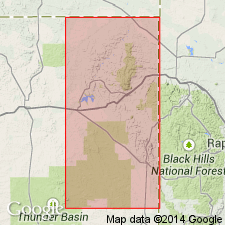
- Usage in publication:
-
- Albian Stage*
- Modifications:
-
- Biostratigraphic dating
- Geochronologic dating
- AAPG geologic province:
-
- Powder River basin
Summary:
Is stage of Lower Cretaceous Series. Geochronologic work indicates that time-span of stage may have been 18 m.y. or more. K-Ar dating of two biotite-bearing bentonites collected along northwest flank of Black Hills uplift [eastern Powder River basin], WY. Upper bentonite (99.6 Ma) from base of Newcastle Sandstone lies in barren interval between HAPLOPHRAGMOIDES GIGAS (below) and MILIAMMINA MANITOBENSIS (above) foraminiferal zones. Lower bentonite (104.4 Ma) from bottom of Skull Creek Shale lies near base of H. GIGAS Zone. H. GIGAS Zone is younger than GASTROPLITES Zone (ammonite), and lower part of M. MANITOBLENSIS Zone is older than NEOGASTROPLITES Zone (ammonite). GASTROPLITES fauna is of earliest late Albian age. Therefore, middle-late Albian boundary is older than 104 m.y. With Albian-Cenomanian boundary at 96 Ma, the late Albian spans at least 8 m.y. A preliminary K-Ar age of 108 Ma on plagioclase from a third bentonite in middle Albian of British Columbia, CN indicates latter half of Albian may have spanned 12 m.y.
Source: GNU records (USGS DDS-6; Denver GNULEX).
- Usage in publication:
-
- Albian Age, Stage
- Modifications:
-
- Figure
- Biostratigraphic dating
- AAPG geologic province:
-
- Many basins
GNU Staff, 1988, GNU Staff remark by W.A. Bryant. Revised ammonite zonation of the Western Interior upper Albian and lower Cenomanian.: U.S. Geological Survey Digital Data Series, DDS-6, 1 CD-ROM., release 3
Summary:
Revised NEOGASTROPLITES ammonite zonation by Cobban and Kennedy (1989) interprets Albian-Cenomanian boundary to fall possibly as low as base of the N. cornutus zone. * and ** denote zones with reversed order from previous zonation; [Note: the original stratigraphic order of Reeside and Cobban (1960) has been found to be correct according to discussion with Cobban this date (12/16/93)].
Neogastroplites zonations [We apologise. The figure for this synopsis is being reconstructed.]
Source: GNU records (USGS DDS-6; Denver GNULEX).
For more information, please contact Nancy Stamm, Geologic Names Committee Secretary.
Asterisk (*) indicates published by U.S. Geological Survey authors.
"No current usage" (†) implies that a name has been abandoned or has fallen into disuse. Former usage and, if known, replacement name given in parentheses ( ).
Slash (/) indicates name conflicts with nomenclatural guidelines (CSN, 1933; ACSN, 1961, 1970; NACSN, 1983, 2005, 2021). May be explained within brackets ([ ]).

